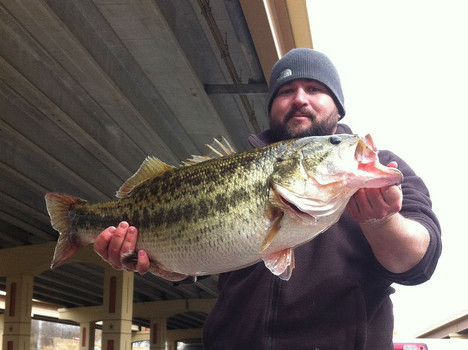It’s Christmas time again, but with a bass fishing twist.
The anticipation of countless little boys and girls at heart soon will come to fruition as they look under their favorite tree for a shiny present, faithfully hoping this is the year they get what they want. And while Santa may not always come through, Mother Nature certainly doesn’t disappoint in gift-wrapping opportunities for anglers across the state when it comes to the ultimate prize — a lunker bass.
Spring is a magical season when it comes to bass fishing, and for good reason — there’s no better time to catch the bass of a lifetime than in the next couple of months on most reservoirs and river systems. Water temperatures that have been downright icy for much of the past few months soon will start to rise, setting the stage for the spawn and making anglers giddy with thoughts of big fish moving up shallower.
Though it’s not an exact science, there are a number of facets of the spawn that anglers can bank on when heading out to their favorite bass fishing locale in coming weeks. Here’s a look at some of those.
Expect the unexpected
The magic water temperature for bass to spawn is about 65 degrees, but some fish will spawn before or after that number is reached. Lake Alan Henry and some other big-bass factories are notorious for having a late spawn, though in some years bass will be on beds in March. This aspect can be good for anglers since it opens up their options. If some fish are holding in staging areas while others have moved up shallow, you can target more water and expect to find fish, including larger females that are looking for a big meal before they spawn. Though backwater creek and cove areas generally are the first places to look for spawning fish in the shallows, bass also could be using underwater highways such as channels to access these spots.
Men at work
The male bass of all varieties (largemouth, smallmouth, spotted, Guadalupe) is the construction worker, building a nest in any type of substrate they find suitable, normally in rocky or gravelly areas, though they also will take to submerged logs and trees. After the female has laid her eggs in the nest, the male will guard over them until the fry hatch. Because the larger females don’t normally spend time on the nest other than to carry out the reproductive process, expect to catch mostly smaller males in the shallows as they will attack any intruder whether live or manmade. On an outing to Alan Henry in early May, I once saw a 3- to 4-pound bass continually knock away a bright green salamander flipped near a nest by a fishing buddy without getting hooked. Even when you can see them, there’s still no guarantee they’ll inhale a barb.
Read the patterns
Weather certainly plays a large role in how bass act this time of year. Cold fronts can wreak havoc with the spawning process, fooling fish into changing up their plans, especially after periods of warmth. Once air and water temperatures stabilize, that’s normally the cue to be on the water in search of a lunker. Monitoring moon phases also is advantageous as many bass, though not all, will lock onto their beds when they’re ready in and around periods of full moon. Since the incubation of bass eggs is aided by sunlight, that too should be something to consider. In turbid water, a bass will construct a nest shallower than in clear conditions in most circumstances. Alan Henry and some other lakes are well-known for their clarity, meaning anglers could find nests in up to 8 or 9 feet of water during the spawn, rather than 2 or 3 feet in murkier locales.
Think outside the tackle box
There’s almost no limit to the type of lure an ornery bass will hit during the pre-spawn, spawn and post-spawn, especially if they’re on a bed or are looking for a hearty meal in a staging area. Critter-type baits, such as salamanders and crawfish – even live ones – surely will tempt any size bass, and jerkbaits, spinnerbaits and crankbaits also will come in handy in the next couple of months in almost any situation. The toughest thing to do is to find a pattern that works, but if you do, you’ll catch fish. At least until a strong norther messes things up.
There already have been multiple fish entered into the ShareLunker program in the new year, which begs the question: Why are you reading this when you could be on the lake?


















